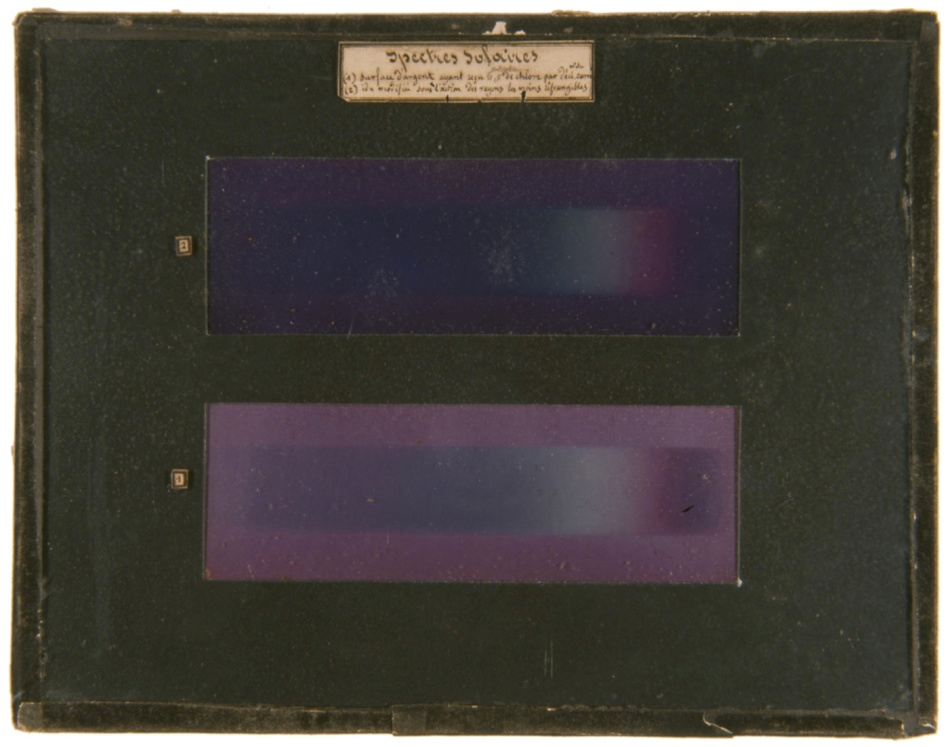Mar 31 2020
The world’s first color photograph seemed like a palette of colors on a silver plate. The photo was taken in 1848 by Edmond Becquerel, a French physicist. The process he followed was empirical, never described, and abandoned soon.
 Edmond Becquerel, Solar spectra, 1848, photochromatic images, Musée Nicéphore Niépce, Chalon-sur-Saône. Image Credit: CNRS.
Edmond Becquerel, Solar spectra, 1848, photochromatic images, Musée Nicéphore Niépce, Chalon-sur-Saône. Image Credit: CNRS.
Researchers at the Centre de Recherche sur la Conservation (CNRS/Muséum National d’Histoire Naturelle/Ministère de la Culture) collaborated with the SOLEIL synchrotron and the Laboratoire de Physique des Solides (CNRS/Université Paris-Saclay) and offer insights into this process.
In a paper published recently in Angewandte Chemie International Edition, the researchers report that colors achieved by Edmond Becquerel were the result of the existence of metallic silver nanoparticles.
In 1848, Edmond Becquerel was successful in producing a color photograph of the solar spectrum at the Muséum d’Histoire Naturelle in Paris. Becquerel named these photographs “photochromatic images,” and they are believed to be the world’s first color photographs.
Some of these photographs have survived as they were light-sensitive and since only a few were produced initially. Other processes for color photography had to be introduced to make it popular among people.
The nature of these colors has been under debate in the scientific society for over 170 years, without any solution.
A research group at the Centre de Recherche sur la Conservation (CNRS/Muséum National d’Histoire Naturelle/Ministère de la Culture, in collaboration with the SOLEIL synchrotron and the Laboratoire de Physique des Solides (CNRS/Université Paris-Saclay), has found a solution.
The researchers first reproduced Edmond Becquerel’s process to create samples of various colors, and then started by re-evaluating 19th-century theories in the context of 21st-century tools. If the colors were created as a result of pigments formed due to reaction with light, differences in chemical composition from one color to another should have been observed, which has not been revealed by any spectroscopy technique.
In case the colors were due to interference, such as the shades of certain butterflies, the colored surface should have exhibited normal microstructures with the size of the wavelength of the corresponding color. But no periodic structure was seen when electron microscopy was used.
But an examination of the colored plates showed that metallic silver nanoparticles were present in the matrix composed of silver chloride grains—and the positions and distributions of sizes of these nanoparticles change based on color.
The researchers consider that the nanoparticles contained in the sensitized plate reorganize based on the light’s color (and thus its energy): some fragment and others combine. The latest configuration provides the material the capacity to absorb all colors of light, other than the color that caused it: and thus, that is the color that can be seen.
Nanoparticles with characteristics associated with color is a phenomenon that physicists know by the name surface plasmons—electron vibrations (in this context, it refers to those of the metallic silver nanoparticles) that propagate in the material. This hypothesis was confirmed by using a spectrometer in an electron microscope that measured the energies of these vibrations.
This study was funded by the SACRe programme at the Université PSL, the Observatoire des Patrimoines de Sorbonne Université and the CEA and CNRS’s national network for transmission electron microscopy and atom probe microscopy.